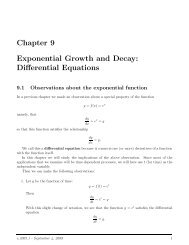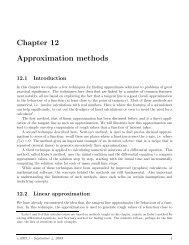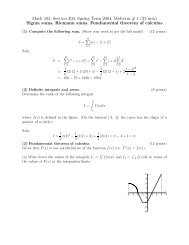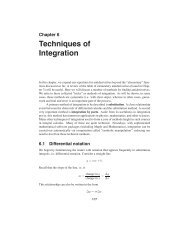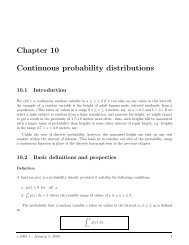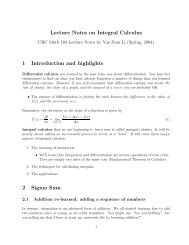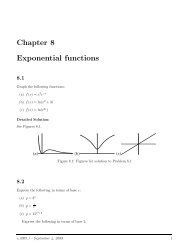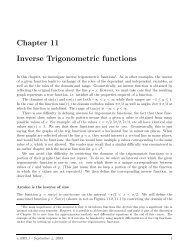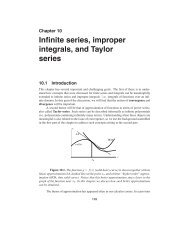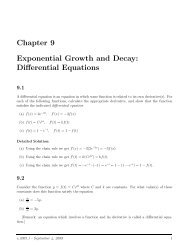Chapter 4 Applications of the definite integral to rates, velocities and ...
Chapter 4 Applications of the definite integral to rates, velocities and ...
Chapter 4 Applications of the definite integral to rates, velocities and ...
You also want an ePaper? Increase the reach of your titles
YUMPU automatically turns print PDFs into web optimized ePapers that Google loves.
Math 103 Notes <strong>Chapter</strong> 4DefinitionThe average value <strong>of</strong> f(x) over <strong>the</strong> interval a ≤ x ≤ b is¯f = 1b − a∫ baf(x)dx.RemarkThis type <strong>of</strong> average should not be confused with <strong>the</strong> mean or average <strong>of</strong> a distribution in <strong>the</strong>context <strong>of</strong> probability, <strong>to</strong> be seen later on in this course.Example 1Find <strong>the</strong> average value <strong>of</strong> <strong>the</strong> functiony = f(x) = x 2over <strong>the</strong> interval 2 < x < 4.Solution¯f = 14 − 2∫ 42x 2 dx = 1 2x 33∣42¯f = 1 6(4 3 − 2 3) = 28 3Example 2: Day length over <strong>the</strong> yearSuppose we want <strong>to</strong> know <strong>the</strong> average length <strong>of</strong> <strong>the</strong> day during summer <strong>and</strong> spring. We will assumethat day length follows a simple periodic behaviour, with a cycle length <strong>of</strong> 1 year (365 days). Letus measure time t in days, with t = 0 at <strong>the</strong> spring equinox, i.e. <strong>the</strong> date in spring when night <strong>and</strong>day lengths are equal. (On that data, <strong>the</strong> length <strong>of</strong> <strong>the</strong> day is 12 hrs.) We will refer <strong>to</strong> <strong>the</strong> number<strong>of</strong> daylight hours on day t by <strong>the</strong> function f(t). (We will also call f(t) <strong>the</strong> length (in hours) <strong>of</strong> <strong>the</strong>day during a given part <strong>of</strong> <strong>the</strong> year.)A simple function that would describe <strong>the</strong> cyclic changes <strong>of</strong> day length over <strong>the</strong> seasons is( ) 2πtf(t) = 12 + 4 sin365The average day length over spring <strong>and</strong> summer, i.e. over <strong>the</strong> first (365/2) ≈ 182 days is:v.2005.1 - January 5, 2009 15



